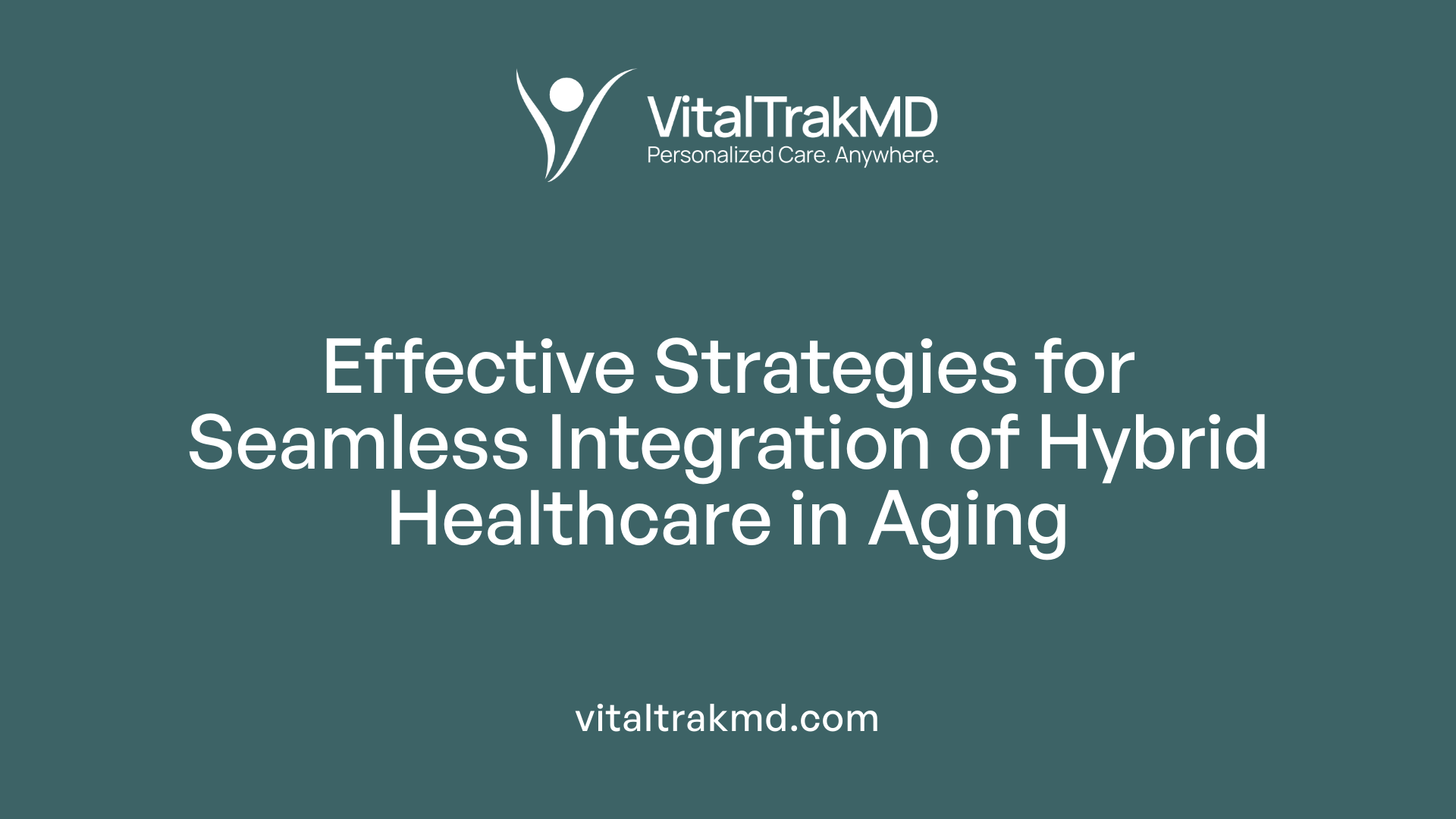Why Hybrid Healthcare Is Revolutionizing Aging Care

The Rise of Hybrid Healthcare in Geriatric Medicine
As global demographics shift dramatically toward an aging population, healthcare systems worldwide are seeking innovative models to better serve older adults. Hybrid healthcare—an integrative approach combining digital technologies with traditional in-person care—is emerging as a transformative solution. This article explores how hybrid care models are revolutionizing aging care by improving accessibility, outcomes, equity, and system efficiency, while also examining technological advances, implementation strategies, and future directions.
Key Principles and Structure of Hybrid Healthcare Models in Aging Care
What are hybrid healthcare models, and what are their core principles in aging care?
Hybrid healthcare models in aging care combine traditional face-to-face medical services with innovative digital health technologies such as telemedicine, remote patient monitoring, and comprehensive electronic health records. This integration enables more flexible, accessible, and personalized care options suited to the needs of older adults.
These models prioritize the use of community-based, multicomponent interventions rooted in behavioral and social strategies. For example, programs incorporating self-care education, family support, and caregiver involvement help combat frailty and manage chronic conditions effectively.
A fundamental aspect of hybrid care is the seamless integration of technology with conventional practices. This approach allows healthcare providers to extend their reach beyond hospitals, supporting virtual primary care, hospital-at-home programs, and remote consultations, which have been especially vital during crises like the COVID-19 pandemic.
The structure of hybrid care emphasizes resilience and adaptability. Systems are designed to facilitate smooth transitions between in-person and virtual settings, ensuring continuous care and timely intervention.
For example, remote monitoring devices can alert clinicians to early health deterioration, preventing unnecessary hospitalizations. Virtual visits can be scheduled flexibly, accommodating patient preferences and reducing barriers like transportation challenges.
Ultimately, hybrid healthcare aims to improve health outcomes by promoting patient engagement, enhancing access to care, and supporting a holistic approach to aging. This model fosters a resilient, patient-centered ecosystem capable of responding effectively to individual health needs and system-level challenges.
Benefits of Hybrid Healthcare for Older Adults

What are the benefits of hybrid healthcare for older adults?
Hybrid healthcare significantly enhances how older adults access and manage their care. By combining in-person visits with virtual consultations and remote monitoring, it eases transportation issues and mobility challenges that often hinder routine healthcare engagement for seniors.
This model also promotes health equity, helping to close gaps in care among racial and ethnic minorities, rural populations, and underserved communities. It ensures more equitable access to specialist services and continuous monitoring regardless of location.
Personalization and ongoing care are improved through integrated digital tools, such as wearable devices and virtual check-ins. These enable tailored treatment plans and early intervention for chronic conditions, fostering better health management.
Cost savings are another advantage. Hybrid care can reduce hospital admissions, emergency visits, and unnecessary in-person appointments. It also lessens caregiver burden by providing remote support and real-time health data.
In summary, hybrid healthcare offers an adaptable, patient-centered approach that meets the diverse needs of older adults. It supports timely, equitable, and personalized care delivery, leading to better outcomes and higher satisfaction.
Technological Innovations Driving Hybrid Healthcare
 Hybrid healthcare leverages a variety of advanced technologies that seamlessly blend virtual and in-person care methods. Telemedicine platforms are central, allowing patients to consult with providers via secure video calls, increasing access especially in remote or underserved areas.
Hybrid healthcare leverages a variety of advanced technologies that seamlessly blend virtual and in-person care methods. Telemedicine platforms are central, allowing patients to consult with providers via secure video calls, increasing access especially in remote or underserved areas.
Remote monitoring devices, such as wearable sensors, play a crucial role by continuously tracking vital signs like ECG, blood pressure, and oxygen levels. These devices send data in real-time to healthcare providers, enabling early detection of potential issues and ongoing health management.
Artificial intelligence (AI) and data analytics are transforming diagnostics and personalized treatment plans. AI algorithms analyze data from wearables and electronic health records (EHRs) to predict risks, assist in diagnosis, and tailor interventions more effectively.
Security and interoperability are vital for these innovations. Blockchain technology ensures the secure, immutable management of patient data, promoting trust and compliance. Simultaneously, robust communication frameworks facilitate real-time data exchange among diverse devices and systems, ensuring that healthcare providers have access to comprehensive and timely information.
These technological integrations support more accessible, efficient, and patient-centered care, enhancing remote monitoring capabilities, improving outcomes, and reducing healthcare costs across various clinical environments.
Implementing Hybrid Care: Strategies and Challenges

What are effective implementation strategies for integrating hybrid healthcare into aging care systems?
Successfully embedding hybrid care models into elderly healthcare services involves several coordinated strategies. First, comprehensive staff training and education are vital. This ensures healthcare providers are proficient in digital tools, telehealth platforms, and remote monitoring technologies, fostering a smooth transition from traditional to digital practices.
Secondly, investing in robust digital infrastructure is essential. Secure, interoperable electronic health records (EHRs), reliable communication platforms, and data-sharing standards like HL7 and SNOMED CT enable seamless information flow across care settings.
Third, establishing structured workflows and protocols supports consistent service delivery. Frameworks such as PRISM and organizational redesign strategies help integrate new practices into existing systems, ensuring sustainability.
Careful stakeholder engagement, including older adults and their caregivers, enhances acceptance. Tailoring communication and involving patients in decision-making processes build trust and empower them to utilize hybrid solutions confidently.
Regulatory and security considerations are also critical. Ensuring compliance with data privacy laws and cybersecurity standards such as ISO 27001 and Cyber Essentials Plus safeguards patient information, fostering confidence among users.
Combining these elements creates a comprehensive approach to hybrid care implementation. When executed effectively, this strategy improves healthcare accessibility, optimizes resource utilization, and delivers better outcomes for aging populations.
Promoting Health Equity and Addressing Disparities with Hybrid Systems
 Hybrid healthcare plays a vital role in fostering health equity, especially among aging populations. By combining in-person visits with virtual care options like telehealth and remote monitoring, this model improves access for underserved communities, including those in rural or socioeconomically disadvantaged areas.
Hybrid healthcare plays a vital role in fostering health equity, especially among aging populations. By combining in-person visits with virtual care options like telehealth and remote monitoring, this model improves access for underserved communities, including those in rural or socioeconomically disadvantaged areas.
One significant advantage of hybrid systems is their ability to bridge geographic gaps. Older adults who face mobility issues or live far from healthcare facilities can receive timely care without traveling long distances. This flexibility helps to eliminate transportation barriers, ensuring consistent management of chronic diseases and routine health needs.
Inclusion is further promoted through policies that support digital health access for various racial and ethnic groups. Deploying culturally sensitive virtual services and providing technological assistance helps address disparities rooted in socioeconomic status, language, and digital literacy.
Studies indicate that hybrid healthcare reduces long-standing disparities by expanding service availability across diverse populations without notable racial or ethnic differences in utilization rates. This approach supports aging in place, decreases unnecessary hospitalizations, and enhances ongoing health management.
In essence, hybrid models utilize both human expertise and advanced technology to tailor care, making it more accessible and equitable. As a result, they contribute significantly to closing health gaps and promoting better outcomes for elderly individuals across different communities.
| Aspect | Benefit | Additional Notes |
|---|---|---|
| Access in underserved populations | Improved reach in rural and low-income areas | Virtual care reduces travel and transportation barriers |
| Bridging geographic and socioeconomic gaps | Flexible, remote options for diverse needs | Supports aging in place & chronic disease management |
| Inclusive digital health policies | Culturally sensitive, language support | Ensures equitable technology adoption |
| Reducing disparities | No significant racial/ethnic usage gaps | Enhances healthcare continuity & engagement |
Focusing on Specific Health Issues: Frailty and Muscle Health
 Managing frailty and muscle health in older adults is a complex challenge that hybrid healthcare models are increasingly addressing effectively.
Managing frailty and muscle health in older adults is a complex challenge that hybrid healthcare models are increasingly addressing effectively.
Assessment and early detection are critical components. Digital tools such as remote monitoring devices and comprehensive assessments help identify early signs of frailty based on physical, psychological, and social factors. By continuously tracking parameters like gait speed, strength, and activity levels, healthcare providers can intervene promptly, aiming to prevent or reverse frailty.
Behavioral and social interventions play a vital role. Studies have shown that integrating behavioral strategies focused on self-efficacy—confidence in managing one's health—along with social support, leads to improved physical performance. Community-based programs that promote social engagement and healthy lifestyle habits foster resilience and reduce frailty scores.
Family and caregiver involvement significantly enhances these efforts. Caregivers provide essential support for daily activities and reinforce health behaviors. Fostering positive interdependence within families encourages adherence to tailored activity and nutrition plans, amplifying the benefits of hybrid care.
Improving physical and psychological outcomes hinges on a holistic approach. Hybrid models combine in-person assessments with digital interventions, enabling personalized care plans that address multifaceted needs. These models support mobility, reduce fall risk, and improve mental well-being.
Overall, hybrid healthcare offers a promising pathway to address frailty and muscle deterioration by enabling early detection, fostering supportive behavioral changes, and empowering caregivers, which collectively lead to healthier, more autonomous aging.
The Future of Aging Care in a Digital World
As the global population continues to age rapidly, the integration of digital technologies into traditional healthcare practices offers a pathway to more resilient, equitable, and efficient systems of care. Hybrid healthcare models empower seniors to age in place, improve health outcomes, and foster independence while alleviating systemic burdens such as workforce shortages and healthcare costs. Going forward, innovations in AI, remote monitoring, and interoperable platforms will further refine personalized care strategies, ensuring that aging populations worldwide can enjoy healthier, more connected lives. Embracing hybrid healthcare is not just a choice but a necessity to meet the expanding demands of aging societies.
References
- Healthcare's Future Is a Hybrid Model
- Comparing In-Person Only, Telemedicine Only, and Hybrid ...
- Digital health for aging populations
- Designing for flexibility in hybrid care services - PubMed Central
- Hybrid model of care for older persons for improvement of ...
- Going Beyond Digital: Why Hybrid Care is the Future of ...
- Setting a Solid Foundation for Hybrid Health Care Success
- What Is Hybrid Healthcare? | Tools, Benefits, and Solutions
- How Can Telehealth Help Address an Aging Population?
- Investing in AgeTech: Serving the Growing Senior ...
Recent articles
Want to Feel Better and Live Healthier?
Join hundreds of patients taking control of their health with personalized care that fits their life – not the other way around.
Rated 4.8/5 by 32+ customers







